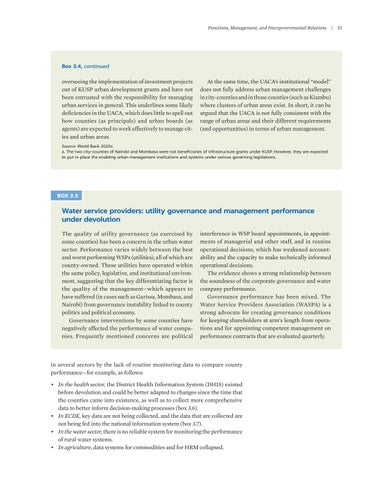Functions, Management, and Intergovernmental Relations
Box 3.4, continued
overseeing the implementation of investment projects out of KUSP urban development grants and have not been entrusted with the responsibility for managing urban services in general. This underlines some likely deficiencies in the UACA, which does little to spell out how counties (as principals) and urban boards (as agents) are expected to work effectively to manage cities and urban areas.
At the same time, the UACA’s institutional “model” does not fully address urban management challenges in city-counties and in those counties (such as Kiambu) where clusters of urban areas exist. In short, it can be argued that the UACA is not fully consistent with the range of urban areas and their different requirements (and opportunities) in terms of urban management.
Source: World Bank 2020c. a. The two city-counties of Nairobi and Mombasa were not beneficiaries of infrastructure grants under KUSP. However, they are expected to put in place the enabling urban management institutions and systems under various governing legislations.
BOX 3.5
Water service providers: utility governance and management performance under devolution The quality of utility governance (as exercised by some counties) has been a concern in the urban water sector. Performance varies widely between the best and worst performing WSPs (utilities), all of which are county-owned. These utilities have operated within the same policy, legislative, and institutional environment, suggesting that the key differentiating factor is the quality of the management—which appears to have suffered (in cases such as Garissa, Mombasa, and Nairobi) from governance instability linked to county politics and political economy. Governance interventions by some counties have negatively affected the performance of water companies. Frequently mentioned concerns are political
interference in WSP board appointments, in appointments of managerial and other staff, and in routine operational decisions, which has weakened accountability and the capacity to make technically informed operational decisions. The evidence shows a strong relationship between the soundness of the corporate governance and water company performance. Governance performance has been mixed. The Water Service Providers Association (WASPA) is a strong advocate for creating governance conditions for keeping shareholders at arm’s length from operations and for appointing competent management on performance contracts that are evaluated quarterly.
in several sectors by the lack of routine monitoring data to compare county performance—for example, as follows: • In the health sector, the District Health Information System (DHIS) existed before devolution and could be better adapted to changes since the time that the counties came into existence, as well as to collect more comprehensive data to better inform decision-making processes (box 3.6). • In ECDE, key data are not being collected, and the data that are collected are not being fed into the national information system (box 3.7). • In the water sector, there is no reliable system for monitoring the performance of rural water systems. • In agriculture, data systems for commodities and for HRM collapsed.
|
51


